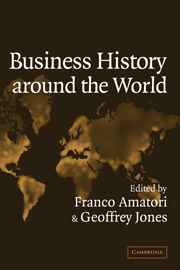Book contents
- Frontmatter
- Contents
- Acknowledgments
- List of Contributors
- Business History around the World
- 1 Introduction
- PART I GENERAL ISSUES, OPEN QUESTIONS, CONTROVERSIES
- PART II AREA PATTERNS
- PART III COMPARATIVE BUSINESS HISTORY
- 16 Family Firms in Comparative Perspective
- 17 Multinationals
- 18 Business-Government Relations: Beyond Performance Issues
- 19 The Opportunities for Business History at the Beginning of the Twenty-First Century
- Index
- References
16 - Family Firms in Comparative Perspective
Published online by Cambridge University Press: 24 July 2009
- Frontmatter
- Contents
- Acknowledgments
- List of Contributors
- Business History around the World
- 1 Introduction
- PART I GENERAL ISSUES, OPEN QUESTIONS, CONTROVERSIES
- PART II AREA PATTERNS
- PART III COMPARATIVE BUSINESS HISTORY
- 16 Family Firms in Comparative Perspective
- 17 Multinationals
- 18 Business-Government Relations: Beyond Performance Issues
- 19 The Opportunities for Business History at the Beginning of the Twenty-First Century
- Index
- References
Summary
At the end of the twentieth century, family firms remained numerically important in virtually all economies and continued to make valuable contributions in terms of both employment and wealth generation. In Europe in the mid-1990s, the overwhelming majority of registered companies were family-owned, ranging from 70 percent in Portugal to over 95 percent in Italy. In the United States, 12.2 million family firms generated almost one-third of the gross domestic product and employed 37 percent of the workforce. While most family firms are small or medium-sized, and while many are destined to be short-lived, a significant number in the mid-1990s were large, long-established international businesses. A third of the companies in the Fortune 500 listing of the largest American firms were family-controlled and include Ford, Bechtel, Mars, Estée Lauder, and Levi Strauss. There is a similar array of prominent names in Europe such as Michelin, Bic, and L'Oréal (France); Tetrapak, the Wallenberg group, and IKEA (Sweden); Lego (Denmark); Fiat, Benetton, Armani, Ferrero, and Barilla (Italy); and C&A and Heineken (the Netherlands). In South and East Asia, family and business remain culturally inseparable, and networks of small family firms have often been characterized as alternatives to Western hierarchical organizations. Examples of large family firms include Tata (India) and Kikkoman (Japan), while the giant Korean chaebol is as well a family business. Thus, while family-dominated groups such as the zaibatsu in Japan were swept away during the American occupation, elsewhere family business groups remain an important characteristic in many economies.
- Type
- Chapter
- Information
- Business History around the World , pp. 339 - 352Publisher: Cambridge University PressPrint publication year: 2003
References
- 34
- Cited by

